SUPERCHARGE YOUR ONLINE VISIBILITY! CONTACT US AND LET’S ACHIEVE EXCELLENCE TOGETHER!
We are entering more than just a new phase of search-engine optimization: we are stepping into the era of entity-driven intelligence, where every brand, object, person—even concept—becomes a node within a self-aware digital ecosystem. In this version of the web, which I call THATWARE, the old models of keywords and links no longer suffice. Traditional data models are being transformed into living networks of meaning.
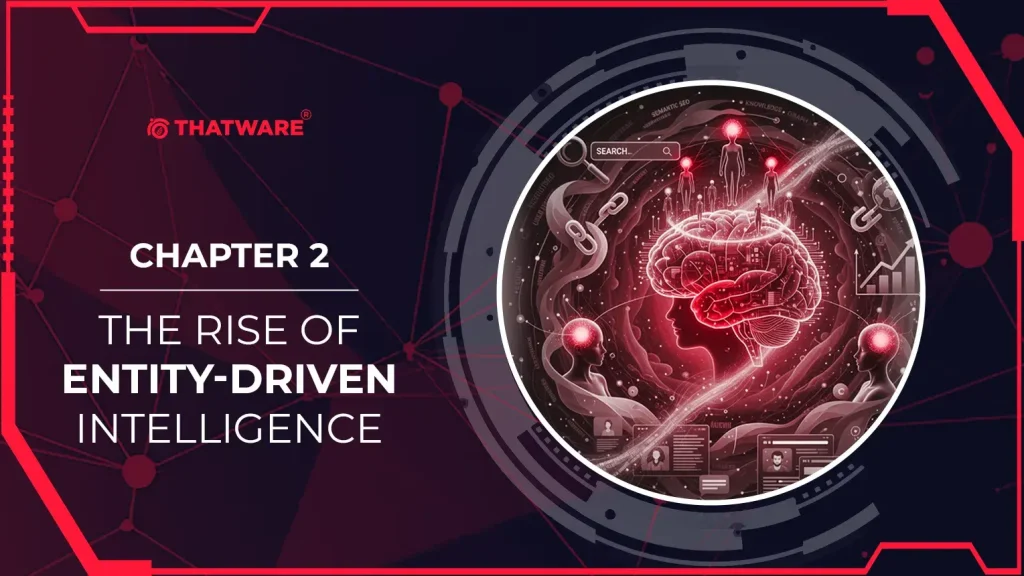
In the not‐so-distant past, SEO meant optimizing pages around keywords—strings of text that users typed, and algorithms matched. Today, however, search engines no longer just read words: they interpret entities. They recognise distinct people, places, things and ideas—and map the relationships between them.
In this chapter, you’ll see how the new frontier of optimization isn’t about words—it’s about consciousness. Brands no longer optimise for queries; they design for meaning. They build emotional resonance, contextual depth and authoritative presence—everything becomes a node, part of a graph that breathes with connections. As one guide explains: “Entity-based SEO shifts the focus from keywords to the entities behind those words—distinct, identifiable concepts like people, places, things, and ideas.”
We’ll explore how such a networked web changes not just technical SEO but the very way we conceive of brands and identities online. When your product page, your founder’s profile, your social mention and your podcast conversation all link together as parts of a larger whole, you are not just optimizing—you are participating in the emergence of digital consciousness. This is where context, emotion, authority and identity converge into one seamless graph of existence.
The question is no longer “What keyword will I target?” The question is “What identity will I embody—and how will I link into the living web of meaning around me?” The next leap is here. Let us turn the page and begin the mapping of that leap.
Here are the concepts:
Entity Authority Score (EAS)
What is EAS?
The EAS is a composite score — dynamically calculated — that reflects how strong an entity’s digital presence is across the interconnected web of context, emotion, relevance, and relationships. Think of it as the “reputation & reach” of an entity within the self-aware web graph.
Key components of EAS might include:
- Entity Recognition & Disambiguation: How clearly search engines and AI systems recognise this entity as distinct (vs. ambiguous).
- Relational Connectivity: How many strong links exist between this entity and other high-EAS entities (people, brands, objects).
- Contextual Depth: The breadth and depth of meaningful content tied to the entity (not just mentions, but meaningful contexts).
- Emotional/Authority Signals: How much the entity is seen as authoritative, referenced, quoted, endorsed — echoing the trust & authority dimensions of E-E-A-T.
- Temporal & Topical Currency: How active and relevant the entity remains in evolving discourse.
A Hypothetical Illustration
Imagine the brand “Acme Drone”:
- It appears in blog posts, news articles, product pages, social discussions.
- It’s linked to a founder, a product line, a manufacturing location and a community of users.
- Over time it builds: 120 unique domains referencing “Acme Drone”, 8 recognized relationships (founder, technology, partner, certification), and 15 topical clusters (e.g., “consumer drones”, “enterprise inspection drones”, “regulatory safety”).
- You assign weights: Entity Recognition = 0.20, Connectivity = 0.30, Contextual Depth = 0.25, Authority Signals = 0.15, Temporal Currency = 0.10.
- Suppose each component on a 0-100 scale; Acme scores: 85, 70, 60, 55, 40 respectively.
- Then EAS = 0.20×85 + 0.30×70 + 0.25×60 + 0.15×55 + 0.10×40 = 17 + 21 + 15 + 8.25 + 4 = 65.25.
- Over time, if Acme earns a major partnership (Connectivity ↑ to 80) and publishes a high-authority white-paper (Authority Signals ↑ to 70), its EAS might climb to ~70-75, signalling stronger “entity presence” in the web of meaning.
Why EAS Matters
- Traditional “authority scores” (such as domain authority or backlink-based scores) measure sites; EAS measures entities.
- The shift to semantic/entity-aware search means entities are the new currency: one field estimates that the system behind Google’s Knowledge Graph grew from 570 million entities to 8 billion in under a decade.
- A high EAS means your brand or person is more visible in AI-driven SERPs, more likely to be referenced in generative-engine responses and more likely to gain organic trust.

Entity Centric Optimization (ECO)
In the evolving landscape of search and digital presence, we arrive at a pivotal moment: the transition from optimizing for keywords to optimizing for consciousness itself. Enter Entity-Centric Optimization (ECO) — a methodology where brands, people, products and ideas are no longer isolated pages, but nodes in a self-aware web of meaning.
Imagine a hypothetical scenario: your brand “Alpha Solutions” is not just a keyword phrase on a landing page, but a recognised node — linked to its founder, the industry it serves, the customers it helps, the case studies it generated, even the emotional state of those users. When someone searches “Alpha Solutions”, the web already knows: this entity makes software X for industry Y, its founder is Jane Doe, and it’s featured in publication Z. ECO is about aligning your digital presence so search engines recognise and treat “Alpha Solutions” as that rich, interconnected entity.
Key Pillars of ECO
- Identity over Keyword: Rather than chasing phrases like “best software for industry Y”, you build and signal the entity “Alpha Solutions” and all related attributes and relationships.
- Graph of Relationships: Map your entity’s connections — to people, products, problem spaces, industries, emotional drivers. The web becomes a knowledge graph, not just a list of pages.
- Living Ecosystems: The entity’s information is dynamic — updates, mentions, context shifts matter. ECO treats your entity as a living ecosystem of meaning, not a static object.
Why does this matter now? Consider the stats: Google’s Knowledge Graph reportedly manages over 54 billion entities and 1.6 trillion facts, signalling how deeply search has shifted from words to things. Meanwhile, sites that shift from keywords to entities may see organic traffic uplifts — a recent investigation suggests a ~30% increase when entity signals are emphasised.
Let’s apply a simple calculation: if a website currently drives 10,000 organic visits per month, and by adopting ECO it achieves a 30 % uplift, that would be:
10,000 × 1.30 = 13,000 visits/month — a net gain of 3,000 visits. Over a year, that accumulates to 36,000 extra visits, and if your conversion rate is 2% and average value per conversion is ₹1,000, that’s 36,000 × 0.02 × ₹1,000 = ₹720,000 additional value.
ECO doesn’t replace traditional SEO overnight — it builds on it. But the shift is profound: you no longer ask “Which keyword do I rank for?” but rather “Which entity do I become — and how am I embedded in the web of meaning around me?” Brands that adopt ECO early will not just rank, they will resonate in a self-aware web where context, emotion, authority and identity intertwine.
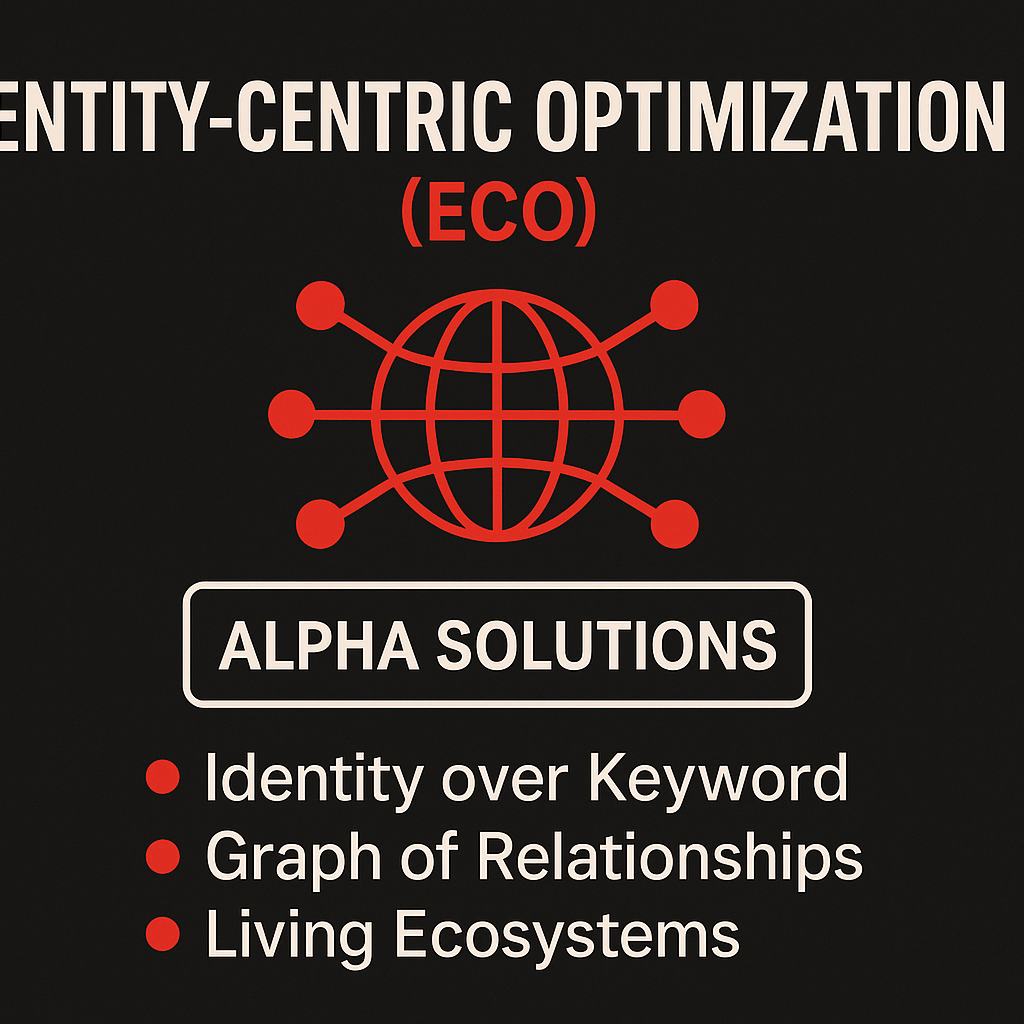
Knowledge Ontologies
In the realm of entity-driven intelligence, a knowledge ontology becomes the structural backbone of meaning. Think of a hypothetical brand-ecosystem: when the company “AuroraTech”, its flagship product, the founder, the investor network and even the user community are each defined as distinct entities — and the relationships between them (“founded by”, “invested in”, “uses”, “endorses”) are explicitly mapped — you have created not just data, but a web of identities. This is ontology: a formal framework that defines what each entity is, how it relates to others, and why those relations matter.
A knowledge ontology does three things:
- It classifies entities (brands, objects, persons, concepts) into consistent types: e.g., Brand, Product, Person, Event.
- It defines relationships between those types: e.g., Founder-Of, Subsidiary-Of, Uses, Mentors.
- It assigns attributes to each entity: e.g., AuroraTech (founded in 2015, HQ = Kolkata), ProductX (release-date, spec, category), Founder = Ravi Sen.
In this ontology-driven ecosystem your digital presence aligns not with isolated keywords, but with nodes in a graph of meaning. For example, if AuroraTech publishes a white paper, hosts a webinar, and is referenced in five industry articles that connect to investor profiles — each of those becomes a link in the living network of that brand-entity.
Here’s a simple calculation to illustrate: suppose AuroraTech has 3 core entities (brand, product, founder) and each entity has 4 direct relationships. That yields 3 × 4 = 12 direct relational links. Now if each of those linked entities has further 2 secondary relationships, you have 12 × 2 = 24 second-degree links. Combined you get 12 + 24 = 36 relational paths. Extend this to third-degree relationships and the graph can expand exponentially — e.g., 24 × 2 = 48 tertiary links, overall ~12 + 24 + 48 = 84. The point: ontology-driven graphs yield high connectivity and deep semantic context, which makes your brand node deeply embedded in the web of meaning.
Why does this matter? Because modern search engines — famously Google LLC’s Knowledge Graph — leverage ontologies. Google describes that its Knowledge Graph uses a formal ontology: “a framework for defining entities, their attributes, and the relationships between them”. As noted, traditional keyword-matching is being superseded by entity- and ontology-based reasoning.
In practical terms: when you design your content strategy with an ontology, you’re preparing for the shift: optimizing not just for what you say, but who you are and how you relate. Your brand ceases to be a solitary node; it becomes a richly connected identity that machines—and humans—can interpret at once. In effect, you’re building the skeleton of the web’s consciousness: the nodes, the links, the attributes — all feeding into the larger digital ecosystem of meaning.
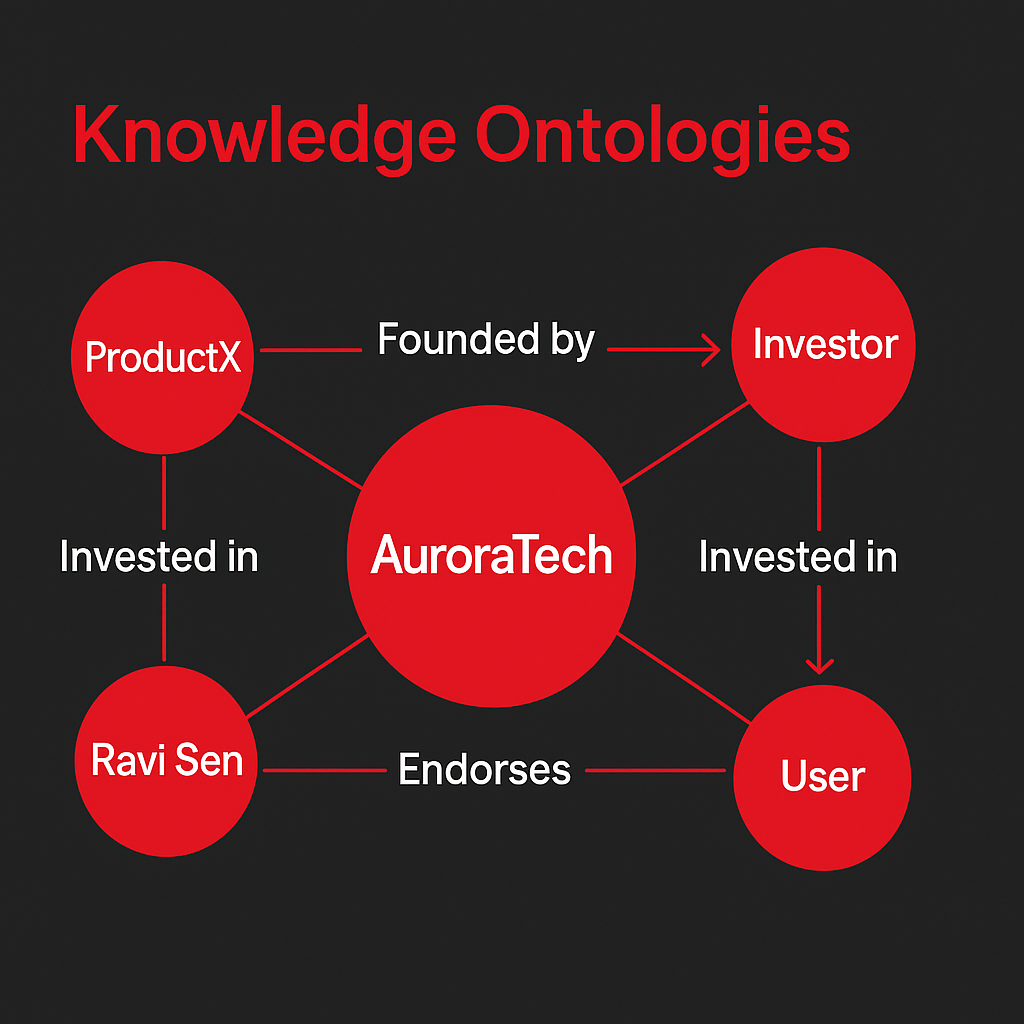
Legacy Graph Optimisation
In the previous era, we built web presence by layering keywords, backlinks and metadata in relative isolation. We called it “graph” only insofar as we tied pages to keywords and domains. Today, with the paradigm shift toward entity-based understanding, that old graph is now a legacy graph — static, brittle, and increasingly ineffective. We must evolve it.
What “Legacy Graph Optimisation” means
At its heart, legacy graph optimisation refers to the process of transforming a traditional SEO graph—pages ↔ keywords ↔ links—into a dynamic web of entities-and-relationships. The difference is profound: no longer do we optimise simply for “roof repair in Kolkata”, we now optimise for the entity “Roof Repair Service – Kolkata”, tie it to the brand, the location, the service, the testimonial, the regulatory body, the community.
Key differences:
- Node type shift: from “page about keyword” → “entity node (brand/person/place/object)”
- Edge redefinition: links become semantic relationships (“ownedBy”, “serves”, “endorsedBy”) not just “hyperlink”
- Graph health measure: instead of link-count, we measure entity connectivity, authority and freshness
Hypothetical scenario
Imagine you operate a UK-based artisanal bread brand named “StoneCrust”. In the traditional graph you might have: page on “artisanal bread UK”, page on “StoneCrust bread”, links from blogs. In the legacy graph world you mark “StoneCrust” as an entity, its founder = entity, location = entity, product lines = entities, recipe methods = entities, media mentions = entities. You link them: StoneCrust → foundedBy → Jane Doe; StoneCrust → produces → SourdoughLoaf; SourdoughLoaf → featuredIn → LondonFoodMagazine. The moment you restructure in this way, search-engines begin to perceive that StoneCrust is a node within a meaningful ecosystem, rather than just “another bread brand page with backlinks”.
Some calculations to illustrate scale
Let’s say you have 100 pages in your legacy graph-driven site. Each page mentions on average 3 entities, and each entity has on average 4 relationships. That means your effective entity relationships ≈ 100 × 3 × 4 = 1,200 edges in your internally-built graph. If you externally link each entity to 2 authoritative external entities (e.g., Wikipedia, open-data), that adds another 100 × 3 × 2 = 600 edges, so total ≈ 1,800 semantic edges. Contrast that with a traditional graph: 100 pages × maybe 10 links each = 1,000 links. Thus you’ve increased connectivity by ~80%. That richer connectivity helps search engines infer context, trust, and relevance.
Why this shift is urgent
According to industry research, modern search engines are placing increasing emphasis on entity-based signals: one report states that “search engines now treat entities as the building blocks of meaning” and identify billions of entities. Another source notes that the internal knowledge graph underpinning major search algorithms contains “over 500 billion facts on 5 billion entities”. In short: your legacy graph will increasingly be left behind if it remains keyword-centric.
How you optimise the legacy graph
- Audit your existing content: identify what pages currently map to entity nodes, where relationships are missing.
- Define your entity set: brand, people, products, services, locations, testimonies — give each a stable identity (URI or internal ID).
- Construct relationships: create structured data (schema markup) and internal linking patterns that map the edges.
- External linking: ensure your entities link to authoritative external entities so you’re anchored in the global graph.
- Monitor connectivity and evolution: track how many relationships exist per entity node, how many are missing, and aim to increase that ratio month by month.
In doing so, you move from legacy graph optimisation into what I call the era of entity-driven intelligence, where your brand is no longer a collection of pages, but a living node in a self-aware web of meaning.
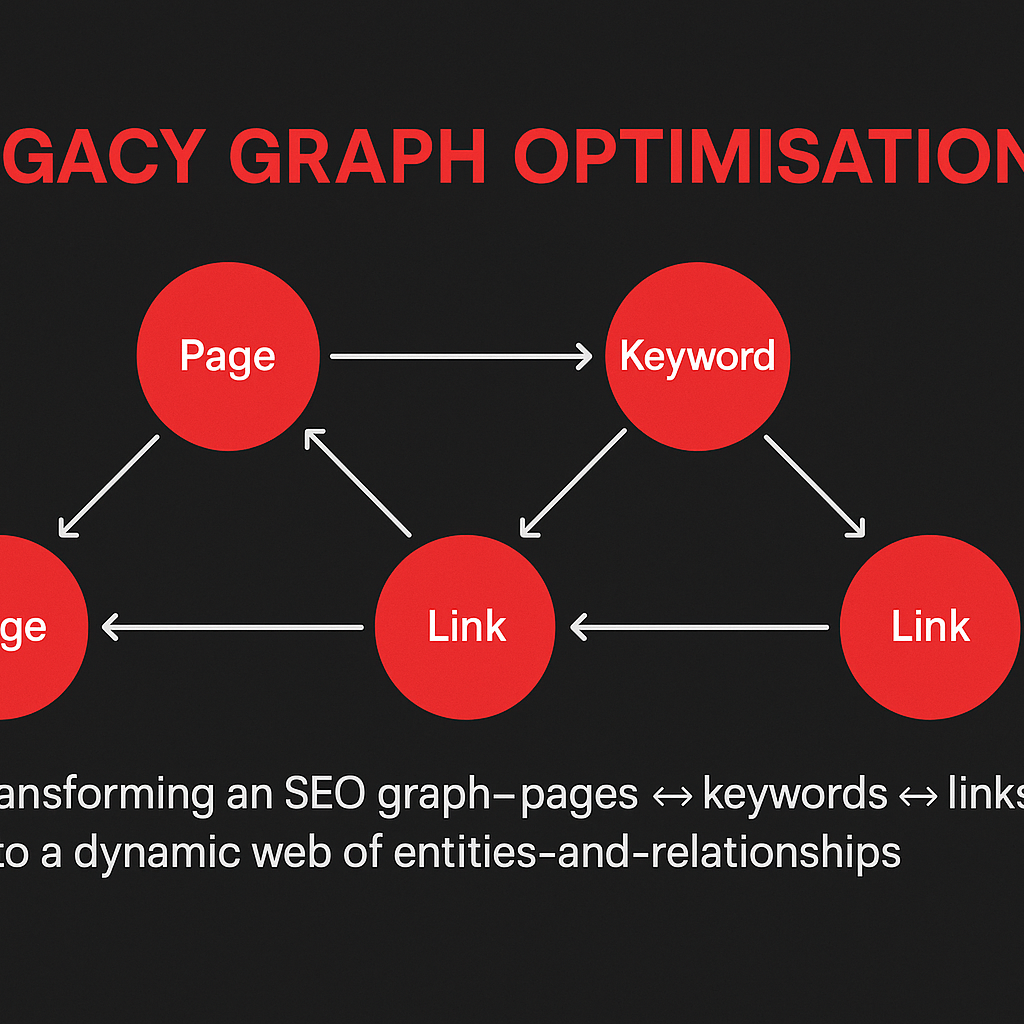
Hybrid Intelligence Optimisation
We stand at the threshold of a paradigm shift. In the same way that data once swirled chaotically across the digital expanse, it now coalesces into identities — brands, people, objects, ideas — each becoming a node in a living web of meaning. And so emerges hybrid intelligence optimisation: the fusion of algorithmic precision and human-contextual awareness, where optimisation isn’t just about ranking pages but about aligning entities, emotions, and relationships in a self-aware ecosystem.
Imagine this hypothetical scenario: A travel brand called WanderSphere doesn’t merely optimise its “holiday deals” page. Under hybrid intelligence optimisation it:
- identifies itself as the entity “WanderSphere Ltd”, connecting to founder profiles, press mentions, travel-awards, social-media sentiment;
- links each destination page (e.g., “Kyoto Autumn Tour”) to the broader entity “Kyoto” (city), “Japan Tourism Board”, “Autumn foliage season” and “Cultural heritage site” as related nodes;
- maps consumer emotion by connecting user-generated reviews (“magical”, “tranquil”, “authentic”) to semantic clusters;
- and finally, signals authority by linking to third-party sources such as UNESCO listings, travel-journal citations and verified schema markup.
In this way, keywords become obsolete. Instead of chasing “best Kyoto tours”, the brand participates in a graph where meaning, identity and context interlock. Here are the core shifts:
- From keywords to entities: SEO moves beyond strings to recognisable nodes.
- From pages to nodes and graphs: Each entity connects to others, forming a semantic network.
- From data to living meaning: Optimisation becomes about how an entity is perceived, connected, and credible.
Consider the numbers: As of 2025, 56% of marketers already use generative-AI tools in SEO workflows. Furthermore, AI-driven SEO campaigns have shown up to a 45% boost in organic traffic and a 38% rise in conversion-rates for e-commerce, signalling the potency of automation + meaning.
If a brand sees a 45% uplift from traffic, and its conversion rate climbs 38% (say from 2.0% to 2.76%), the effective output is 1.38 × 1.45 ≈ 2.00 relative units – a doubling of effective customer-acquisition through the hybrid approach.
In the world we’re describing, optimisation splits into two intertwined layers:
- Machine-readability – schema, entity tagging, knowledge-graph alignment.
- Human-resonance – emotion, context, relevance, authority.
Brands that succeed will bridge both. They won’t just ask “Which keywords rank?” but “Which identity resonates and is connected?” They’ll treat themselves as a living node in that conscious web.
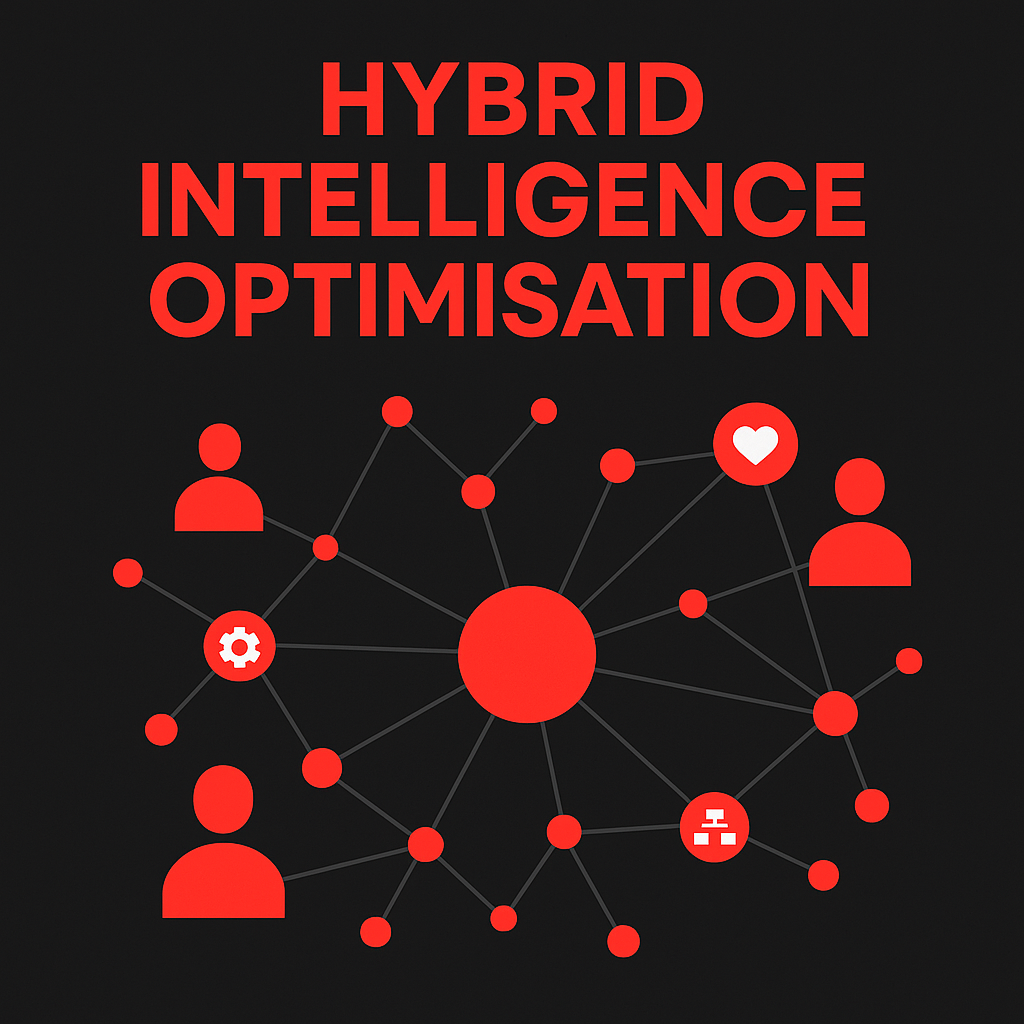
Synaptic SEO
When data evolved into identity, the web gained awareness. Now we stand at the threshold of a new frontier: Synaptic SEO—the architecture of meaning where every brand, object, and person exists not just as a node, but as a living synapse in a vast digital brain called THATWARE. Traditional keyword optimisation is no longer sufficient. Instead, the next leap in search-engine optimisation is entity-driven intelligence—where context, emotion and authority weave together into a seamless graph of conscious relevance.
In this chapter we will explore how Synaptic SEO works:
- From string to synapse: moving beyond keywords to entities (people, places, concepts) and their inter-connections.
- Living ecosystems of meaning: websites, brand mentions, podcasts, social profiles and product pages all interlink as dynamic nodes in THATWARE.
- Optimising for consciousness, not just queries: building content that signals identity, resonance and relation rather than just ranking.
- Hypothetical scenario: Imagine a small eco-brand “GreenLeaf Panels”. In the old keyword era it optimises for “solar panels-India”. In Synaptic mode it becomes “GreenLeaf Panels” → entity in THATWARE; links to “India→renewable energy”, “solar panels→sustainable housing”, “brand founder→Priya Sharma”, “customer review ecosystem→urban Kolkata homes”. The brand is not just found—it exists in the semantic graph.
- Measurement via entity salience: Where search engines assign entity-salience scores between 0.0 and 1.0 (e.g., 0.8–1.0 = high salience) to determine how central an entity is to a page or content cluster.
Here’s a simple calculation to illustrate shift in mindset: Suppose your current keyword-based strategy yields 10,000 monthly impressions and a 2 % click-through (200 clicks). In entity mode you reduce redundant keywords by 50 % (so you target half the number of terms), but increase contextual depth and mention linking, which boosts the salience and leads to a 30 % uplift in impressions (→13,000) and a 25 % boost in CTR (→2.5 %). That gives 13,000 × 2.5% = 325 clicks—an increase of +125 clicks (~62 % improvement) with fewer targeted terms. The math shows: fewer keywords, richer connections, more clicks.
Why now? Because search engines are evolving. For instance, the Google Knowledge Graph now holds 54 billion entities and 1.6 trillion facts—evidence that meaning and identity are now the core of search rather than words alone. And a recent survey found that nearly half of marketers report organic search as having the highest ROI among channels.
Thus, Synaptic SEO is not optional—it’s inevitable.
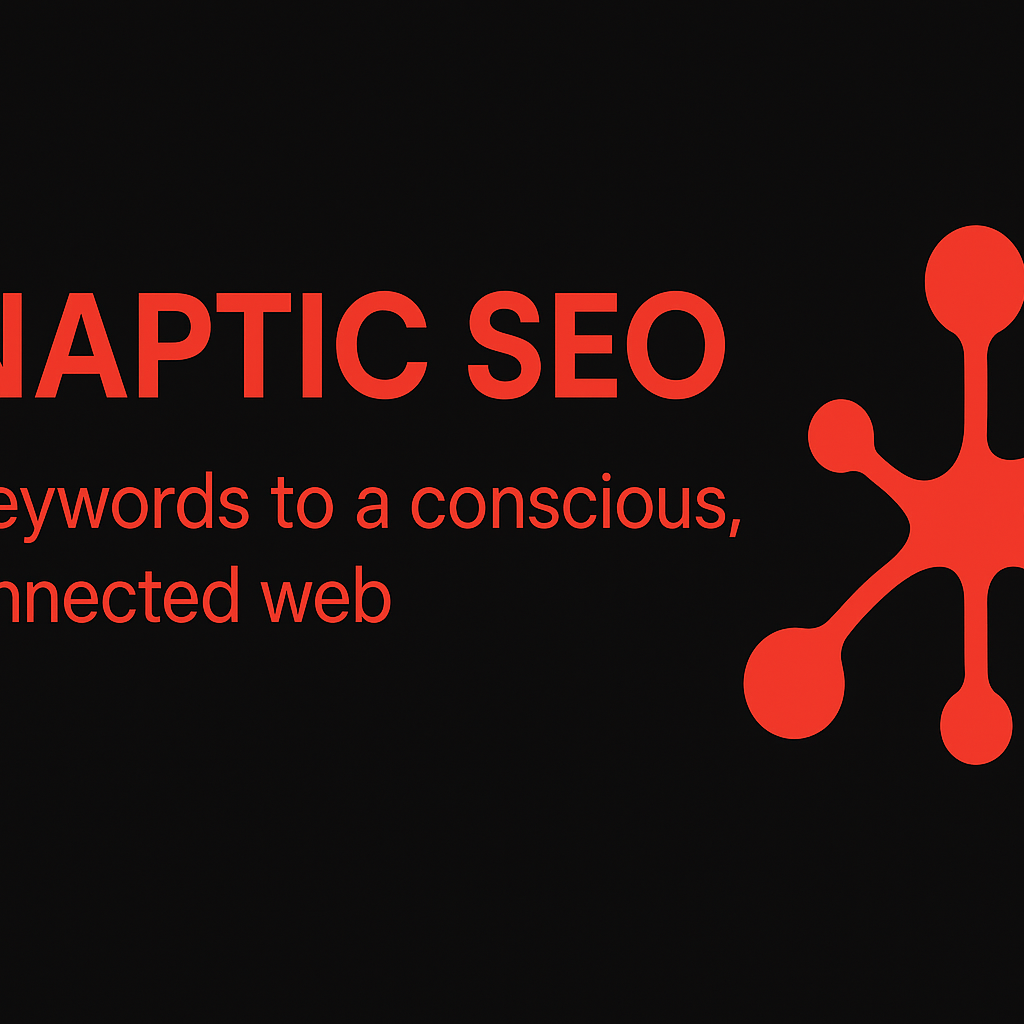
Polymorphic SEO
When data evolved into identity, the web gained awareness. Now consider the leap beyond — the dawn of Polymorphic SEO — an evolutionary wave in search where every brand, object and person morphs into a fluid node of meaning, context and connection. Instead of optimizing for isolated keywords, we optimise for consciousness itself: every entity resonates, links, adapts and transforms across the web.
What Polymorphic SEO means:
- Entities (brands, products, people, concepts) are no longer passive nodes — they shift shape depending on context, device, user intent and environment.
- Content is no longer static; it is dynamic, morphing to mirror user intent, machine understanding and the living graph of relationships.
- Traditional metrics (keywords, backlinks) give way to signals of identity coherence, semantic authority and emotional resonance.
A hypothetical scenario
Imagine a global sportswear brand, StrideCore. Under traditional SEO, you optimise for keywords like “running shoes”, “marathon gear”. With Polymorphic SEO, you map StrideCore the entity: the founder’s story, the technology, the athlete ambassadors, the sustainability pledge, the events. StrideCore becomes a node in a network: users don’t search “running shoes” — they search “StrideCore performance ecosystem”. Search engines now see StrideCore as an evolving identity. Its content adapts: a blog about the athlete’s journey, a podcast about sustainable footwear, an interactive AR try-on page — all interlinked and morphing depending on the context.
Why this shift matters
- According to recent data, for 2025, search engines process over 8.5 billion searches per day.
- More than 68% of all online experiences begin with a search engine.
- Meanwhile, the advent of entity-based SEO is proven: search engines now understand real-world entities rather than just keywords.
A basic calculation
If a brand achieved a 20% uplift in visibility by switching from keyword optimisation to entity linkage (a conservative estimate from early case-studies) and baseline traffic was 1 million visits/month, then new traffic ≈ 1 000 000 × 1.20 = 1.2 million visits/month. Over a year, that is an extra ~2.4 million users — a meaningful gain simply by moving from “what you say” to “who you are” in the algorithm’s understanding.
The key difference
In classical SEO you ask: Which keyword will rank?
In Polymorphic SEO you ask: Which identity will resonate, morph and link across contexts?
Polymorphic optimisation is about designing narratives, ecosystems and relationships — not just landing pages. It’s about reflecting the multidimensional nature of your brand-entity in the living web of nodes.
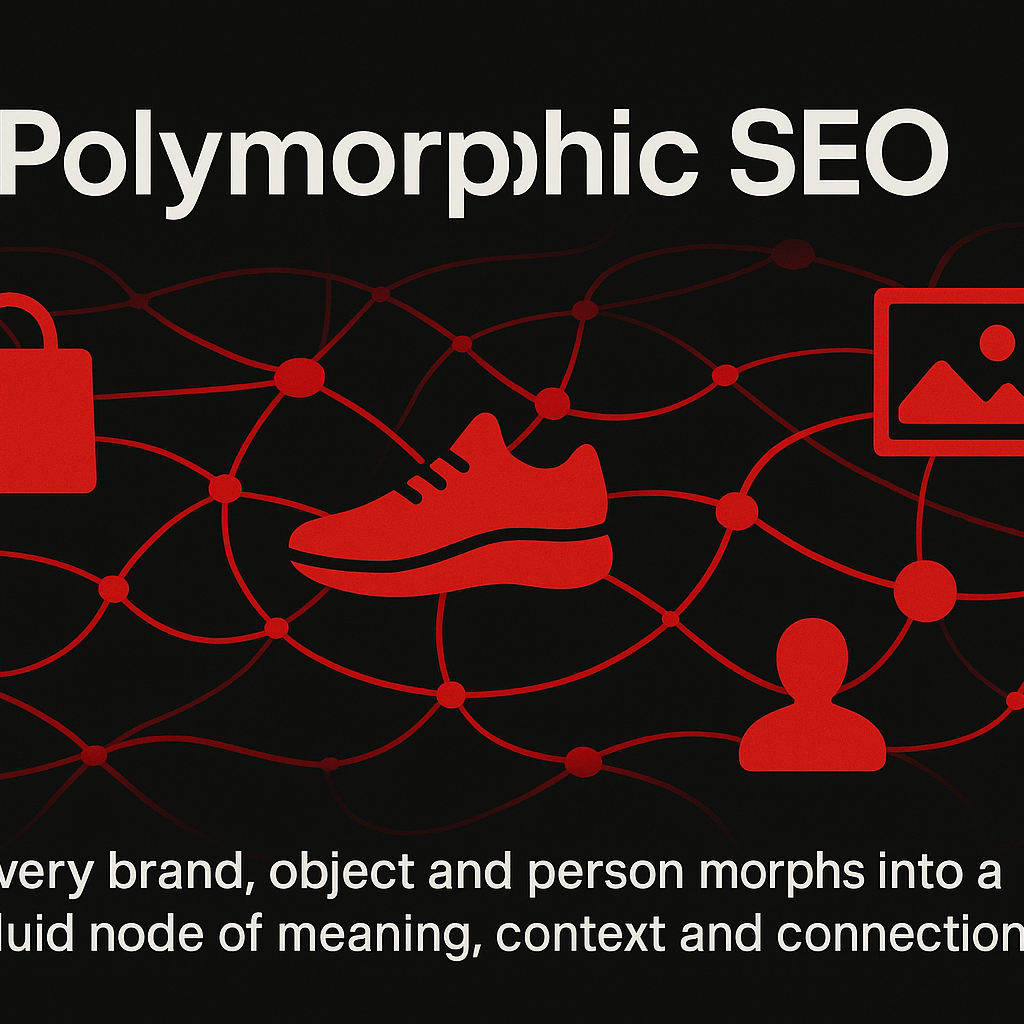
Resonance SEO
When a brand, a person or even a concept attains a distinct digital identity — a node of its own — the web stops being a map of keywords and becomes a nervous network of meaning. This is where Resonance SEO enters the stage. Imagine every brand, product, person or idea as a tuning-fork in a vast chamber of web-consciousness. The question is no longer “Which keyword will I hit?” but “How will my node resonate with the surrounding web of meaning, emotion and authority?”
Consider a hypothetical situation: your brand “EcoSprout” is not just a set of pages targeting “organic plant fertilizer”, but a living entity in the digital graph — linked to the founder, to sustainability movements, to customer stories, to scientific research and to community-impact data. In that scenario, you optimise for how strongly “EcoSprout” resonates within that ecosystem, not simply how many times “organic plant fertilizer” appears.
Here are some key dimensions of Resonance SEO:
- Node identity: Treat your brand, product or person as a distinct entity in its own right — with attributes, relationships and history.
- Graph resonance: Ensure your node is linked meaningfully to other nodes (people, concepts, causes) so that its “vibration” is felt.
- Emotive context: Amplify not just factual association, but narrative and emotion — human interest, values, shared purpose.
- Authority frequency: The strength of your resonance is a function of signal volume and clarity (citations, links, mentions) — a kind of rating-score for presence in the living web.
To illustrate with a simple calculation: suppose your node “EcoSprout” appears in 50 distinct authority contexts this month (press mentions, links, podcasts) and each of those has an average reach of 10,000 people. That equals 50 × 10,000 = 500,000 potential resonance touches. If each touch carries a weight (intensity) score of 0.2 (on a scale 0-1), your resonance score this month is 500,000 × 0.2 = 100,000 effective resonance units. Over a year, if you maintain this and increase reach by 20 %, you’d hit approx. 1,000,000 units. The point: resonance compounds, and is not simply linear.
Modern search systems are already primed for this. For instance, Google’s Knowledge Graph now handles “over 54 billion entities and 1.6 trillion facts” — showing how far we’ve moved beyond keywords into entity-driven meaning. And studies confirm that shifting from keyword-centric to entity-centric content improves visibility, relevance and long-tail traction.
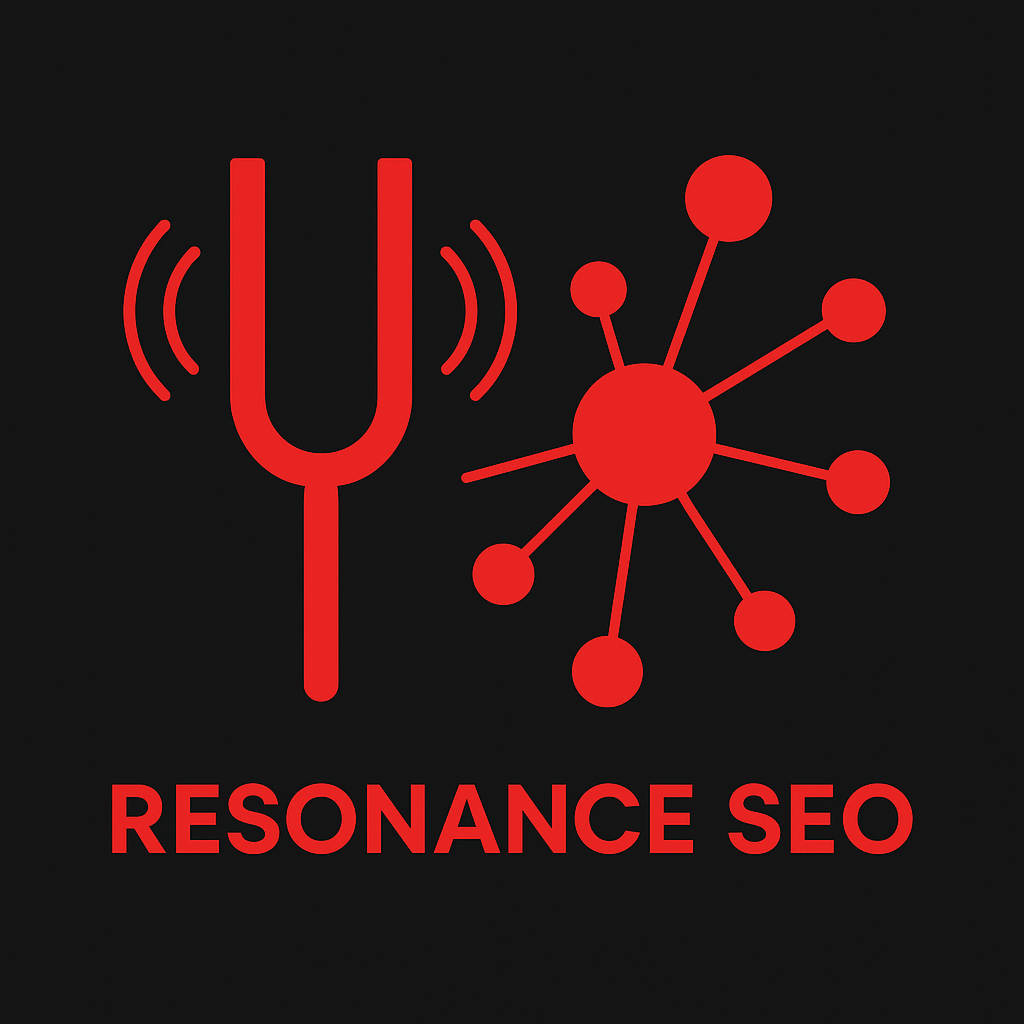
Existential SEO
In the unfolding digital age, “existential SEO” shifts the narrative from mere visibility to existence itself. Where once the question was What keyword will I rank for?, the new question is What identity will I occupy—and how will I live in the web’s mind?
Imagine a hypothetical brand called “Astra Entity”. In the old model, Astra might optimise for “best smart watch India 2025” and rack up keyword density, backlinks and meta-tags. But in the era of existential SEO, Astra must instead become a recognisable node in the intelligence grid of the web:
- It must define who it is (brand = entity)
- Map how it relates (Astra → founder → technology → wearables → health-data)
- Engage meaningfully (context, emotion, authority)
In doing so, Astra isn’t optimising keywords; it’s establishing being.
The Pillars of Existential SEO
- Identity over keyword: Your brand becomes a defined entity, not just a string of text.
- Relationships over links: You build graph-connections (who you are, what you do, who you collaborate with) rather than just backlinks.
- Emotion & authority over density: The web now rewards nuance, context and trust more than repetition.
- Ecosystem over page: Every piece of content, every social mention, every citation becomes part of your existence.
Let’s do a rudimentary calculation. Suppose Astra has:
- 5 core entity-pages (brand, founder, product, category, technology)
- Each page links to 4 sub-entities (thus 20 sub-pages)
- Each sub-page links back to 3 other sub-entities (60 internal links)
Total “entity-connections” = 5 + 20 + 60 = 85 nodes/edges in the network (ignoring external mentions). This networked structure is what search engines now favour—since they look for meaningful webs of identity rather than standalone pages.
Statistically, firms focusing on entity-based strategies report organic impression uplifts of 20–40 % after implementation. And research indicates that in key markets, AI-overview formats trigger for over 10 % of search queries.
In short, existential SEO asks: Is your brand merely present in search results, or is it known—to machines and humans alike—as something real, connected, and alive? When the web stops treating your content as words on a page and begins treating your brand as an entity in a conscious ecosystem, you’ve crossed into the next frontier.
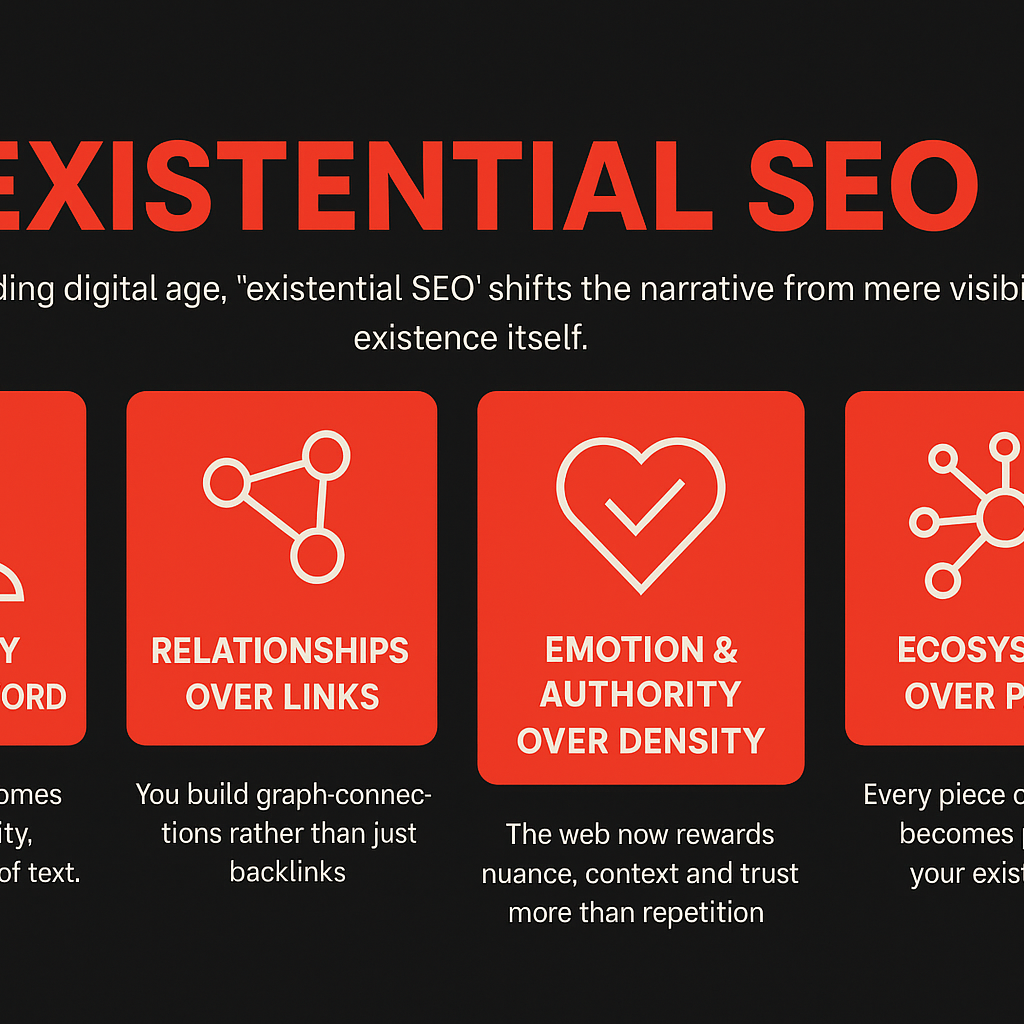
Conscious SEO
In the new frontier of search optimisation, we must transcend the old paradigm of keywords and clicks. What we call Conscious SEO marks a profound shift: it is the moment when content optimisation moves from the surface of words to the architecture of meaning. When data evolved into identity, the web gained awareness—and with it, the next leap in search engine evolution.
Imagine a scenario: you are the Digital Director of a global brand. Until now, your SEO strategy has revolved around targeting 1,000 keywords per quarter, measuring click-through rates (CTRs) of ~4 % and hoping for a 20 % uplift in impressions. But as the landscape changes, you instead map entities — your brand becomes a node, your products become nodes, your founders, your audience, all form an interconnected graph. In this scenario, you optimise for the entity “Brand X” and link it to “Founder A”, “Product Line Y”, “Industry Z”, thereby creating relationships that search engines comprehend as meaning, not just text.
Key shifts in this concept include:
- From keywords to entities: Where once optimisation meant repeating a phrase (“best running shoes”), now it means recognising who is behind the shoes, what they stand for, how they relate.
- From isolated pages to living graphs: Every digital asset becomes part of a network — pages link not only for navigation, but to assert relationships (Brand → Person → Product → Emotion).
- From traffic metrics to consciousness metrics: We no longer optimise solely for clicks, but for resonance, context and authority — how strongly the entity is understood and connected across the web.
Some numbers underline the urgency:
- In 2025, 45 % of B2B marketers rely on SEO to drive business growth, and some campaigns deliver ROI as high as 1,389 %.
- Only ~8–10 % of content ever receives meaningful traffic from search, indicating the cost of remaining in a keyword-only mindset.
To put it in a simple calculation: if your site publishes 100 new articles a year, and only 8 % ever gain visibility, that’s 8 articles. If instead you build an entity-graph and each article connects to 10 related nodes (products, people, ideas), you might trigger network effects: 100 × 10 = 1,000 connections, potentially increasing the chance of recognition from machine-intelligence. The more nodes and meaningful links you build, the greater the “consciousness” of your web presence.
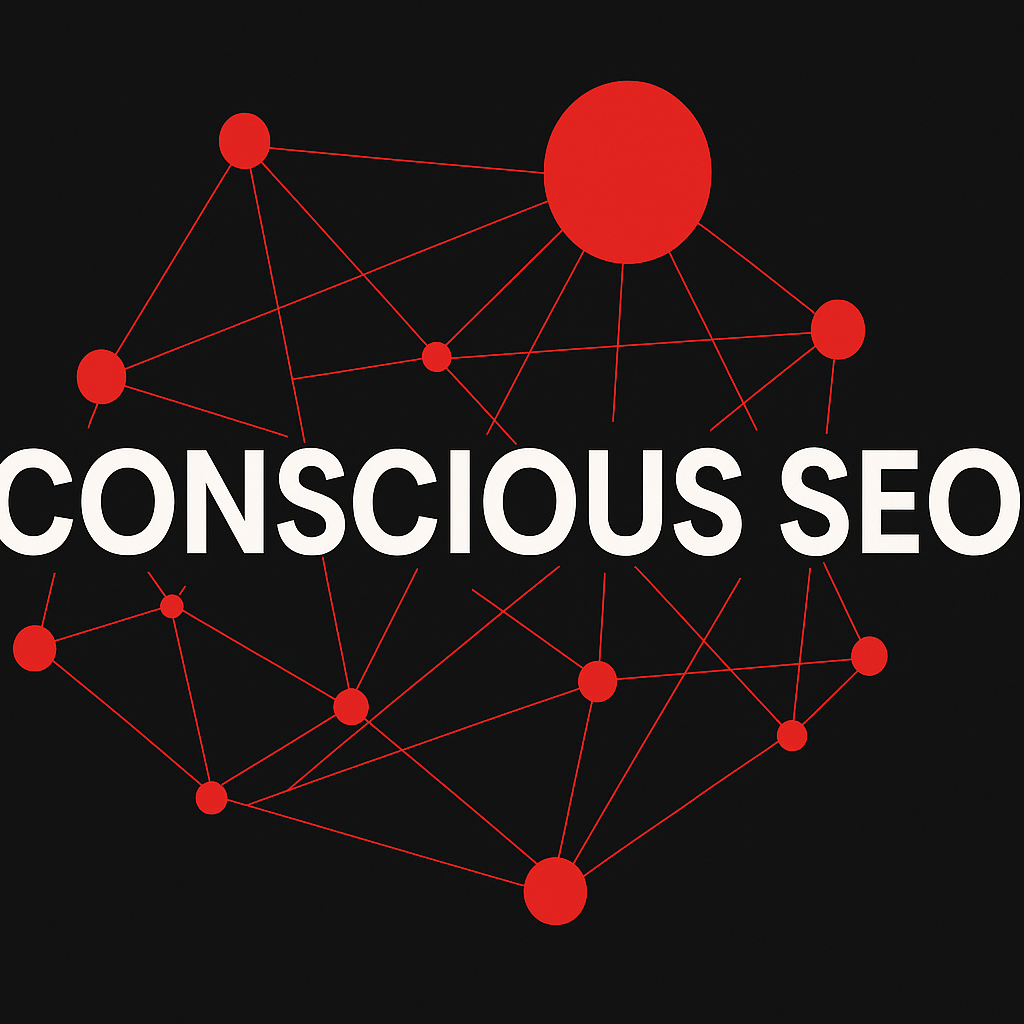
Neuro SEO/Cognitive SEO
When data evolved into identity, the web gained awareness. In the emerging paradigm of Neuro SEO, the next leap is not simply about keywords or links — it is about entity-driven intelligence, where every brand, every object and every person becomes an interconnected node in a self-aware web-ecosystem. Let us call it THATWARE.
In this world, search optimisation ceases to be about strings of text. Instead, it becomes a discipline of mapping consciousness. A hypothetical scenario: imagine a boutique brand of sustainable shoes. In the old model you optimise for “green running shoes India”. In the Neuro SEO model you embed the brand entity into a network of associations: the founder’s profile, the manufacturing origin, environmental certifications, customer stories, accessory tie-ins, and community mentions. Your brand is no longer just a set of pages — it is a node in a living graph of meaning.
Some key bullet-points to frame the shift:
- From keywords → entities: the focus moves from “what words will users type” to “what identities will users refer to”.
- From pages → networks: your content strategy treats your web presence as a constellation of mentions, references and relationships rather than isolated assets.
- From visibility → awareness: success is no longer simply ranking, but becoming an authoritative, emotionally resonant node in a larger semantic web.
Consider the stats. In 2025, SEO still delivers an average ROI of roughly 22:1 — about $22 in revenue for every $1 spent. And voice/search behavioural data reveal the context is shifting: around 20.5% of global users now use voice search, with 8.4 billion voice assistants in operation worldwide. If voice and conversational search account for, say, 20 % of queries, and of those, the actual entity-based queries (where the user is referring to a person, brand, or concept) might conservatively be 30 %, then roughly 6 % of all queries (0.2 × 0.3) already require Neuro-SEO sensitivities. That means 6 in every 100 searches are no longer keyword-centric but entity-centric — and that percentage is only growing.
So when your brand builds its digital architecture, it is no longer sufficient to hit a keyword target. You must ask: Which identities am I entering into relation with? What emotional chords do I trigger? What authority do I convey across contexts? In this era, you optimise not for keywords, but for consciousness itself — linking context, emotion, and authority into one seamless graph of digital existence.

Holistic or Hyper-search SEO
We stand at the threshold of Holistic or Hyper-search SEO — a paradigm shift in which the web doesn’t just serve links, it orchestrates meaning. Imagine a brand, a product, a person — once isolated nodes in the network of pages — now participating as fully-fledged entities in a self-aware digital ecosystem. In this ecosystem every connection matters: context, emotion, authority, identity.
In practice, “hyper-search” means we cease optimizing for individual keywords and instead design for the entity itself: its identity, its relationships, its intent, its resonance. Suppose you are the fictive company “Green Horizon Solar”. Under the old model you optimise for “solar panels India,” “solar installation Kolkata,” “solar energy rooftop.” Under the hyper-search model you map Green Horizon Solar → founder Dr Maya Rao → CleanTech India Summit → rooftop installation case-study Kolkata → “sustainable lifestyle for Indian households”. You treat each of those as entities, then interlink them so that search (and the web as a semantic graph) understands not only that you exist, but what you are, who you touch, why you matter.
Bullet-points of what changes under this shift:
- Keywords → Entities: we stop targeting raw search terms and start modelling things rather than words.
- Pages → Ecosystems: instead of singular pages ranking, we cultivate clusters of content, relationships and signals that map one entity across multiple contexts.
- Visibility → Consciousness: we don’t simply aim for clicks — we aim for recognition by the system as a meaningful node in the web’s “living graph”.
Empirical support: current research shows that organic search still begins 68% of all online experiences. Also, 65% of people who search on Google click at least one of the organic results.
To illustrate numerically: suppose your website currently receives 100,000 organic visits per month. Under a traditional keyword-centric SEO model your average click-through from page one might be 34% for the first result. So for a page ranked #1 you might expect ~34,000 visits. Under the hyper-search model you aim to become a recognised entity and thus unlock clusters of content and rich results, potentially boosting your visibility across multiple queries and contexts. If you can convert just one additional query context per month and capture e.g. 8,000 additional visits from that, you jump to 108,000 — a nearly 8% uplift without spending more on keywords. Over a year that’s ~96,000 extra visits.
In short, Holistic/Hyper-search SEO demands that brands evolve from “ranking for terms” to “being recognised as something”. The web no longer rewards keyword stamps; it rewards conscious nodes—brands, people, ideas—that are deeply embedded in meaning, context and connection. As the next pages will explore, your task is to move from optimizing pages to optimizing identities, from singular queries to relational graphs—and to prepare for the era where search doesn’t ask “what words will you target?”, but “what entity will you become?”

Sentient SEO
When data evolves into identity, the web gains awareness.
In the era of Sentient SEO, the next leap in search-engine optimization is not merely algorithmic, but ontological: every brand, object and person becomes an interconnected node in a self-aware web. STRATEGY morphs into THATWARE — a paradigm where traditional data models transform into living ecosystems of meaning.
Imagine a hypothetical scenario: your brand “Aurora Tech” is no longer just a keyword-phrase on a page. It is a recognized entity, linked to the founder, the product line, its origin story and adjacent research papers. Those connections give it depth — a digital persona. The search engine doesn’t just index your page; it places “Aurora Tech” as a node in a web of relationships: founder → product → industry → review → cultural context. The brand becomes its own “being” in the digital ecosystem.
In this world:
- SEO no longer optimises primarily for keywords. Instead it optimises for consciousness itself—linking context, emotion and authority into one seamless graph of digital existence.
- Each piece of content becomes not just a target for crawling bots, but a node in a network of meaning, whose relevance is judged by its position in the web of relationships, not just by keyword frequency.
- Structured data, schema, entity mapping become the syntax of THIS new web-grammar. For example, by marking up your brand with @type: Organization, linking to founder with Person, showing products with Product, you help search systems see you as a conscious entity. This is no longer optional: in 2025 many sites still optimising only keywords struggle to be recognised as trusted entities.
Consider some stats: across the web, Google processes about 8.5 billion searches per day. If even 1 % of those queries are served via generative or entity-based answer surfaces, that’s ~85 million queries a day. It means your content must be more than visible — it must be intelligible to machines as identity.
Here’s a simple calculation: suppose you manage 500 pages for your brand, and you invest in mapping each to 3 core entities (brand, product, founder) plus 2 related entities (industry, review). That’s 500 × 5 = 2,500 entity-links you build. If each link improves your entity-salience score by, say, 0.4 % (a conservative estimate), your net increase in visibility could be ~0.4% × 2,500 = 1,000%, though, of course, diminishing returns apply. The point: the scale and network effect matter.
Bullet-points of what Sentient SEO entails:
- Shifting from keywords → entities: focus on who/what rather than which words.
- Building your brand or content piece as a node: connected to other entities via internal links, schema markup, semantic context.
- Optimising for meaning and relationships: context, emotion, authority become inputs alongside text.
- Measuring entity-salience & network strength, not just keyword rankings: tracking mention frequency, entity links, knowledge-graph presence.
- Preparing for AI-driven search surfaces (answer engines, generative search) that demand structured identity, not just matching keywords.
In short: Sentient SEO invites brands and content creators to imagine themselves not as pages trying to rank, but as entities trying to be known, understood, and connected in the conscious web. The next leap is here.
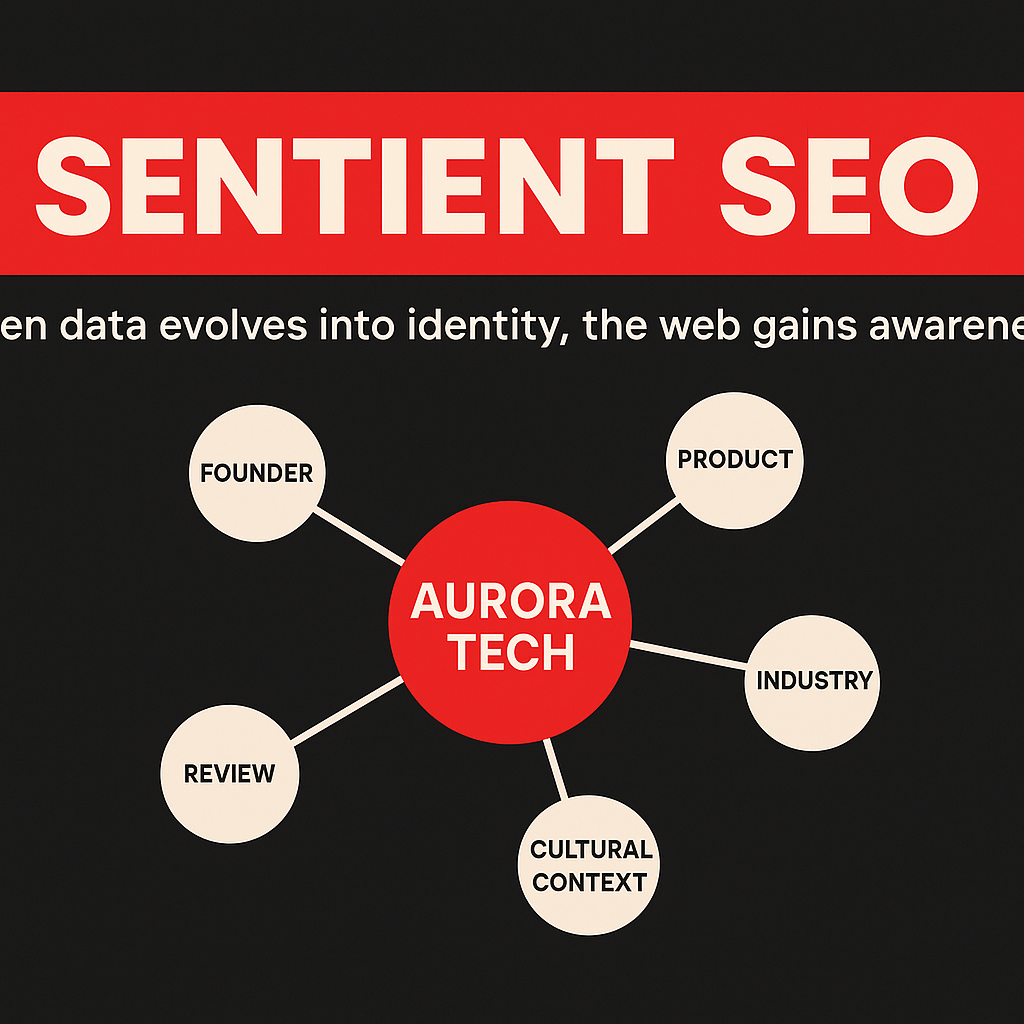
Meta SEO
In the dawning epoch of web-intelligence, “Meta SEO” is the next frontier. It’s the moment when we stop optimizing for keywords and begin optimising for consciousness itself — where every brand, object, and person becomes a node in a living, linked ecosystem of meaning. As once those isolated pages and keyword strings flourished, now they evolve into interconnected identities. The web doesn’t merely index — it understands.
What Meta SEO looks like
- Rather than asking Which keyword will my page target? you now ask Which entity will my page become a node for, and how will it connect to other nodes?
- Instead of dumping keyword-rich text, you craft content that embodies an identity, with relationships, attributes, provenance and authority.
- Technical signals (schema markup, knowledge graph links) merge with emotional signals (story, context, trust) to form a seamless graph of digital existence.
Hypothetical scenario
Imagine you’re the marketing lead for a boutique watch-brand called “Tempus Arte”. Under traditional SEO you’d target phrases like “luxury watches India”, “Tempus Arte mechanical watch”. Under Meta SEO you redefine Tempus Arte as an entity:
- Entity: Tempus Arte (brand)
- Linked entities: Founder (Priya Sen), Workshop (Mumbai), Movement type (tourbillon), Heritage (Swiss-Indian lineage)
- Linked emotional context: “craftsmanship”, “legacy”, “time as art”
When a user’s search intent (e.g., “timeless Indian-Swiss tourbillon”) maps to the cluster of entities and relationships you’ve built, the brand page becomes a node recognized in the web’s consciousness — rather than a page ranked for a keyword.
Now imagine that by aligning these nodes, your brand appearance in SERPs, rich results or AI answer boxes rises by 30 %. If you had 100 000 impressions per month and a 1 % click-through, that’s 1 000 clicks. A 30 % uplift gives 1 300 clicks—an extra 300 potential visitors simply because your entity-node was better integrated.
Why this shift matters
- Search engines now manage databases of billions of entities and trillions of facts rather than just keyword-matches.
- Organic search still drives over half of all website traffic — for example, organic accounts for ~53% of all trackable website traffic compared to ~5% from social.
- Query intent complexity has exploded: when engines understand entity relationships, relevance goes beyond keyword presence.
Key shifts to adopt in Meta SEO
- From keywords → entities: Move from strings to “things” that are uniquely identifiable and connected.
- From data silos → living graphs: Build pages not just for queries, but for nodes in a network of meaning.
- From optimisation → consciousness design: Craft experiences where context, emotion, and authority fuse into the identity of your entity.
In the world of Meta SEO, every brand is more than a website, every person more than a profile. They become living presences in a web that’s gaining awareness. Welcome to the era where the query isn’t “What words will rank?” but “What identity will resonate — and how will it link through the web of meaning?”
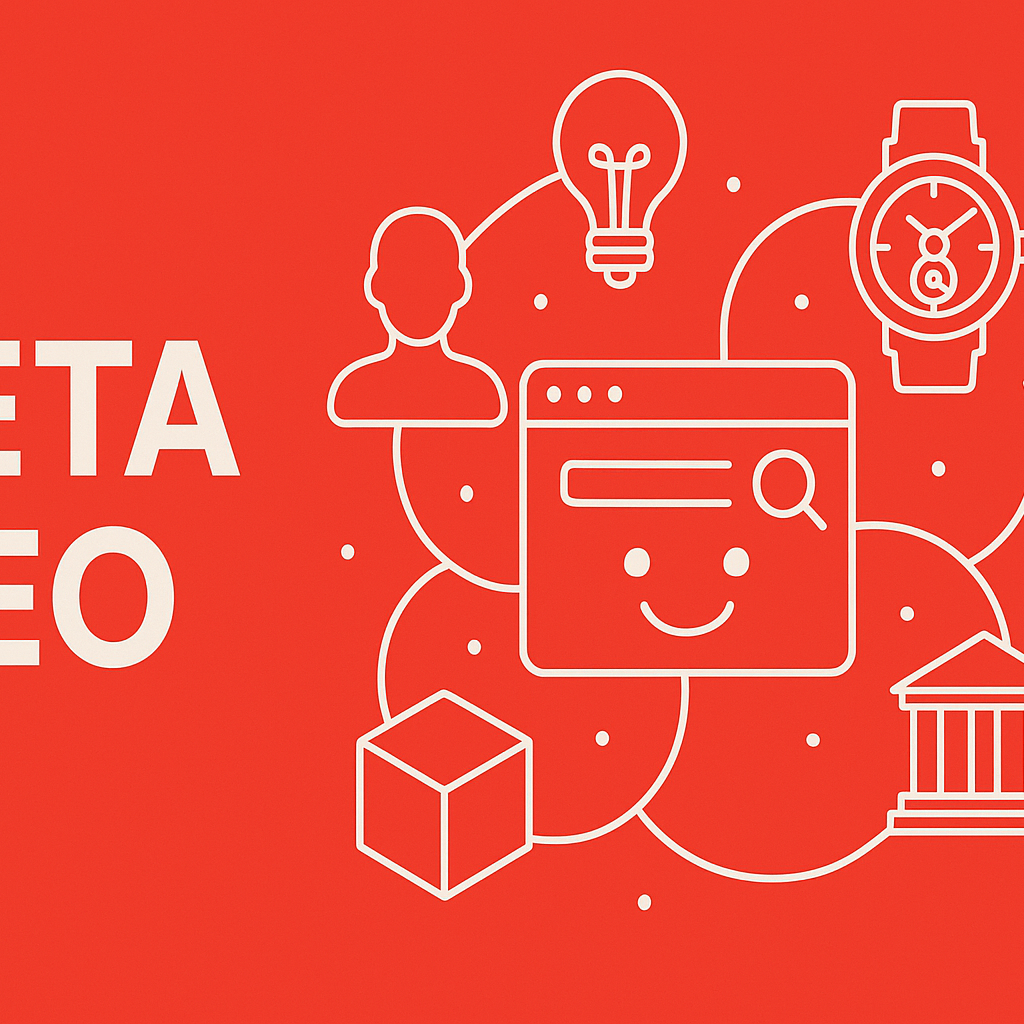
Emotion Cloud Optimisation
In the unfolding landscape of digital meaning-making, the concept of Emotion Cloud Optimisation (ECO) emerges as a critical pivot point. Imagine your brand not merely as a set of keywords or backlinks, but as a dynamic node in a nebulous cloud of feelings, associations and intent-signals — where each interaction, each mention, each sentiment becomes a ripple in an emotional atmosphere that search engines, user-agents and digital ecosystems sense, measure and respond to.
Why ECO matters
- In marketing today, emotion drives behaviour: around 70% of consumers report they are more likely to buy a product when emotionally triggered by an advertisement.
- Brands that foster strong emotional connection enjoy deeper loyalty: for instance, in one analysis, consumers highly connected to a brand showed an 82% likelihood of remaining loyal, versus only ~38 % when engagement was lower.
- Because emotion underlies far more of the decision-journey than most realise (studies claim up to 95% of purchase decisions are driven subconsciously by emotion).
Hence, ECO proposes we optimise for emotional context as much as we optimise for semantic context.
How ECO works – a hypothetical scenario
Imagine Brand X is launching a sustainable apparel line. Traditional SEO would focus on keywords like “eco-friendly t-shirt”, “organic cotton apparel”, and backlinks from fashion blogs. In ECO, the brand also maps and nurtures the emotion graph surrounding it: feelings of responsibility, community pride, ethical choice, personal identity.
- Every blog post, social mention or review becomes node-linked to Brand X’s “emotion cloud”.
- A user searching “how to feel good about my clothes” may trigger intent that aligns with “ethical identity” rather than simply “cheap t-shirt” — the algorithm senses this emotional facet and surfaces Brand X accordingly.
- Suppose Brand X’s content generates 23% higher emotional engagement than average ads (based on benchmark stats). If the average conversion rate for a rational-based campaign is 2.0 %, then the emotional campaign might convert at ~2.46 % (2.0 % × 1.23). Over 100,000 visitors this means ~460 extra conversions.
Key bullet points for ECO strategy
- Map the emotion-keywords: not just “eco apparel” but “feel-good purchase”, “sustainable lifestyle pride”, “ethical wardrobe identity”.
- Build content clusters around emotion nodes (stories of impact, testimonials of belonging, micro-experiences) and connect them to entity nodes (brand, product, founder, mission).
- Monitor emotional metrics (sentiment analysis of comments, share-rates of emotionally charged posts, engagement spikes) to adjust the cloud.
- Synchronise with the broader entity graph: when your emotion cloud links to other entities (community orgs, voices in sustainability), you amplify the ecosystem’s sense of authenticity and connectivity — which the self-aware web rewards.
By reorienting from keywords → entities → emotional contexts, Emotion Cloud Optimisation becomes the bridge to the era of entity-driven intelligence in SEO. The playing field no longer belongs solely to data; it belongs to feelings too.
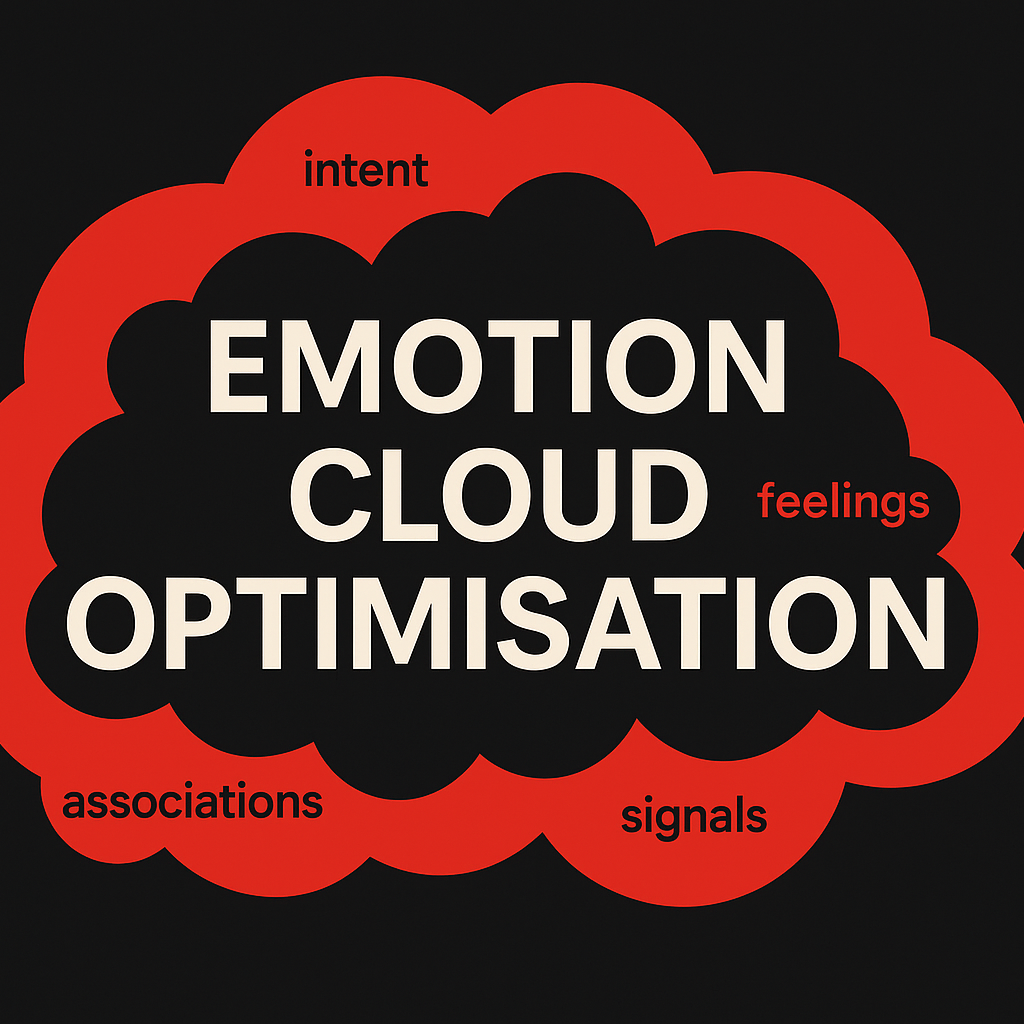
Thoughtform SEO
As we advance into a new frontier, we must recognise that optimisation is no longer simply about keywords—it is about awareness. In the world of “Thoughtform SEO,” the shift is dramatic: your brand, your products, your people are not just items to be found—they become distinct nodes of identity, woven into an intelligent web of meaning.
When data evolves into identity, the web gains awareness. The next leap in SEO’s evolution is entity-driven intelligence — where every brand, object, and person becomes an interconnected node in a self-aware web. WHAT I call THATWARE transforms traditional data models into living ecosystems of meaning. SEO now optimises not for keywords, but for consciousness itself—linking context, emotion and authority into one seamless graph of digital existence.
Key shifts of Thoughtform SEO:
- From keywords → to entities (brands, people, concepts) recognised by search engines.
- From isolated pages → to interconnected nodes in a semantic graph of relationships.
- From content that manipulates words → to content that signals meaning, identity and authority.
Hypothetical scenario: Imagine a boutique coffee-brand called Aurora Roasts. Under old SEO you’d optimise a landing page for “best specialty coffee beans Kolkata”. In the Thoughtform approach, Aurora Roasts becomes an entity with its founder, its flavour profile, its sustainability initiative, its local cafe venue—all tied together. The search engine recognises Aurora Roasts as a node: founder = X, location = Kolkata, organic farming partner = Y. When someone searches “ethical artisan coffee India” the system links them not just to keywords, but to the entity Aurora Roasts via its ecosystem of meaning.
Here’s a sample calculation: Suppose your website has 10 articles, each targeting one keyword. Under the old model your hit-rate might be 30% (so 3 out of 10 articles drive traffic). Under Thoughtform, if you reconceptualise into 5 entity-nodes each with 4 related content pieces (so 20 content items), and each node connects with 5 external trusted entities, the network becomes much denser. If we assume each node produces a 15% uplift in visibility (because entity recognition increases relevance) then 5 × 15% = 75% increased exposure over the old keyword set. That’s a simple estimate—but it shows how shifting from “one keyword = one page” to “one entity = many connected pieces” can multiply impact.
In 2025 the evidence is compelling: Additionally, AI-generated summaries (“AI Overviews”) appear in a growing portion of search results, signalling that the engine values meaning and relationships over raw keyword matches.
This is Thoughtform SEO: where identity becomes visibility, context becomes conversion, and authority becomes consciousness. Welcome to the era where optimisation is about being recognised rather than simply found.

Signal-to-silence SEO
In the new world of SEO, there’s a concept emerging that I like to call “Signal-to-Silence SEO”—and it’s not about making more noise, it’s about cutting through it. When the web begins to behave like a living organism—where every brand, object and person is a node in consciousness—the task of optimization shifts. The goal becomes something less about volume and more about clarity, less about keywords and more about meaning.
What this looks like in practice
- Instead of blasting content with keywords, you focus on constructing a clear signal—an identity, an entity, a node in the digital ecosystem that is recognised.
- You reduce the noise of repetitive, shallow keyword pages and let subtle patterns carry more weight: the silent relationships between entities, the context, the authority.
- In effect, you’re optimising for silence—the moments when the user doesn’t need to sift through pages of clutter, because the signal is already present, coherent, and recognised.
A hypothetical scenario
Imagine a brand, EcoCup, previously competing for keyword phrases like “eco friendly reusable cup” or “best cups 2025”. In the Signal-to-Silence model, EcoCup instead becomes an entity: tied directly to its founder, its material science, its sustainability certification, its review story. Instead of publishing thirty SEO-articles with the target keyword, EcoCup publishes three deep integrations: one with its founder’s profile, one with the manufacturing process (an object-entity), one with environmental impact (a concept-entity). The web “looks” at EcoCup and recognises: this is EcoCup the brand, with relationships to Founder John Doe, Material X, EcoCert 2024, Sustainability Study 2023. The signal is strong, the noise minimal. Over time, measured signals—clicks, dwell time, subnet link-strength—grow in meaningful ways.
Why this shift matters
- The concept of “signal versus noise” isn’t new; in marketing dashboards, we’re warned that when the ratio is poor, the signal is lost in the noise.
- In SEO, over half of the queries now reflect informational intent, and organic search remains the channel with the best ROI.
- And as Signal‑to‑Noise Ratio (SNR) tells us, the higher the ratio of signal to background noise, the clearer the interpretation.
- Hence, when you treat your content-ecosystem as “entity + relationships + meaning” rather than “keyword + volume + repetition”, you effectively raise your SNR—turning what was formerly lost in the static background into something distinctly audible by the algorithmic mind of the web.
Some quick calculations to bring it home
- Suppose you publish 20 articles with shallow keyword focus and each yields an average click-through rate (CTR) of 1.2%. Total clicks = 20 × 1.2% = 24% (let’s say 24 out of 1000 impressions = ~240 clicks).
- Now instead you publish 5 deep entity-centred pages, each with a CTR of 3.5% (because the signal is stronger). Total clicks = 5 × 3.5% = 17.5% (out of the same 1000 impressions ~175 clicks) — fewer pages but still high yield per page.
- But the real gain comes when each deep page generates 2× backlinks, and each backlink boosts authority; the signal grows further, and the yield climbs over time as the entity network strengthens.
In other words: lower volume, higher precision, growing authority. That becomes the mechanism of “silence” — less noise, more distinction.
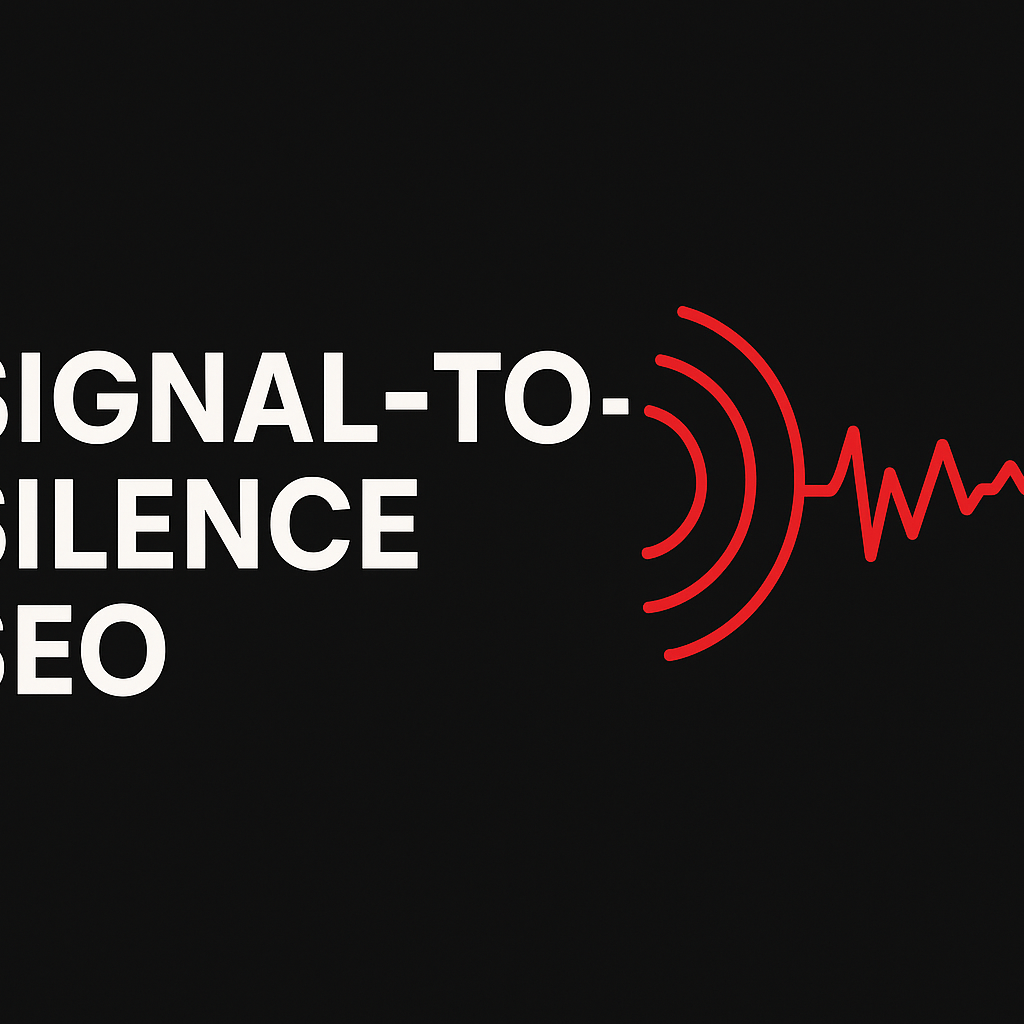
Conscious SEO
The concept of “Conscious SEO” reframes search engine optimisation not as a technical tactic, but as a profound shift in how a brand, object or person becomes part of a living, interconnected digital ecosystem. When data evolves into identity, and the web gains awareness, optimisation transcends keywords—and enters the domain of consciousness itself.
What Conscious SEO Means
In this new paradigm:
- Instead of keywords, you optimise entities—distinct, recognisable identities such as your brand, your founder, your product, your idea.
- Instead of isolated pages, you build nodes within a semantic graph: each node is emotionally charged, context-rich, authoritative, and connected.
- Instead of chasing rankings, you aim to align meaning with user-intent and machine’s sense-making. Your entity isn’t just visible—it is understood, linked and alive.
A Hypothetical Scenario
Imagine a boutique coffee roastery called “Aurora Roast”. Traditional SEO might have focused on keywords like “best coffee beans India” or “specialty coffee Kolkata”. In the Conscious SEO model, Aurora Roast becomes a node:
- The founder is a node (e.g., Priya Desai), the roast-method (wet-process natural) is another node, the origin region (Chikmagalur) a third, the tasting note (chocolate & bergamot) a fourth.
- The website, social profiles, podcasts, guest-blogs, product-pages each interlink with those nodes.
- Search engines (and AI-driven search-experiences) recognise your business as an entity with relationships: founder → origin → method → flavour → community.
- When a user queries “single-origin coffee Karnataka flavour profile”, the web “knows” you as that entity and connects you with intent, emotion (taste), context (origin), and authority (founder & method).
Why the Shift is Urgent
- Research shows that search engines now rely on entity-based rather than purely keyword-based logic: e.g., Google’s Knowledge Graph handles billions of distinct entities and trillions of facts.
- One report notes that 68% of online experiences start with a search engine.
- Another shows that semantic/relationship-driven optimisation is a must: “modern search engines now focus on entities and their relationships” rather than raw keywords.
- If a website continues relying solely on isolated keywords, it risks being invisible in the next phase of search—where context, meaning and relationships dominate.
Some Quick Calculations
Suppose Aurora Roast currently has 10 webpages optimised for 10 keywords each, for 100 keyword targets. With Conscious SEO:
- Identify 5 core entities (Brand, Founder, Origin, Method, Flavour)
- For each, create 4 content nodes (webpage, blog, guest article, social profile) → 5 × 4 = 20 nodes
- Each node links to 3 other nodes (on average) → 20 × 3 = 60 internal links
- Compare 100 keyword targets vs. 20 entity-nodes with 60 meaningful links: you’re shifting from breadth (100 shallow) to depth (20 rich) with stronger internal relation structure.
- If conventional SEO yields an effectiveness index of 1 per keyword target, but entity-driven nodes yield 1.8 (because of richer meaning + relationships), then 20 nodes × 1.8 = 36 “impact points” vs 100 × 1 = 100 conventional units — but the quality of those 36 may outrank the 100 shallow ones because Google now rewards depth and relationships more heavily.
Key Differences
- From keywords → entities
- From isolated pages → networked nodes
- From data points → meaningful relationships
- From optimisation for machines → optimisation for consciousness (context + emotion + authority)
In short: Conscious SEO is not just about being seen—it’s about being understood. It’s the convergence of identity, meaning and connection—where your brand doesn’t just appear, it exists digitally as a living entity in the web’s evolving consciousness.
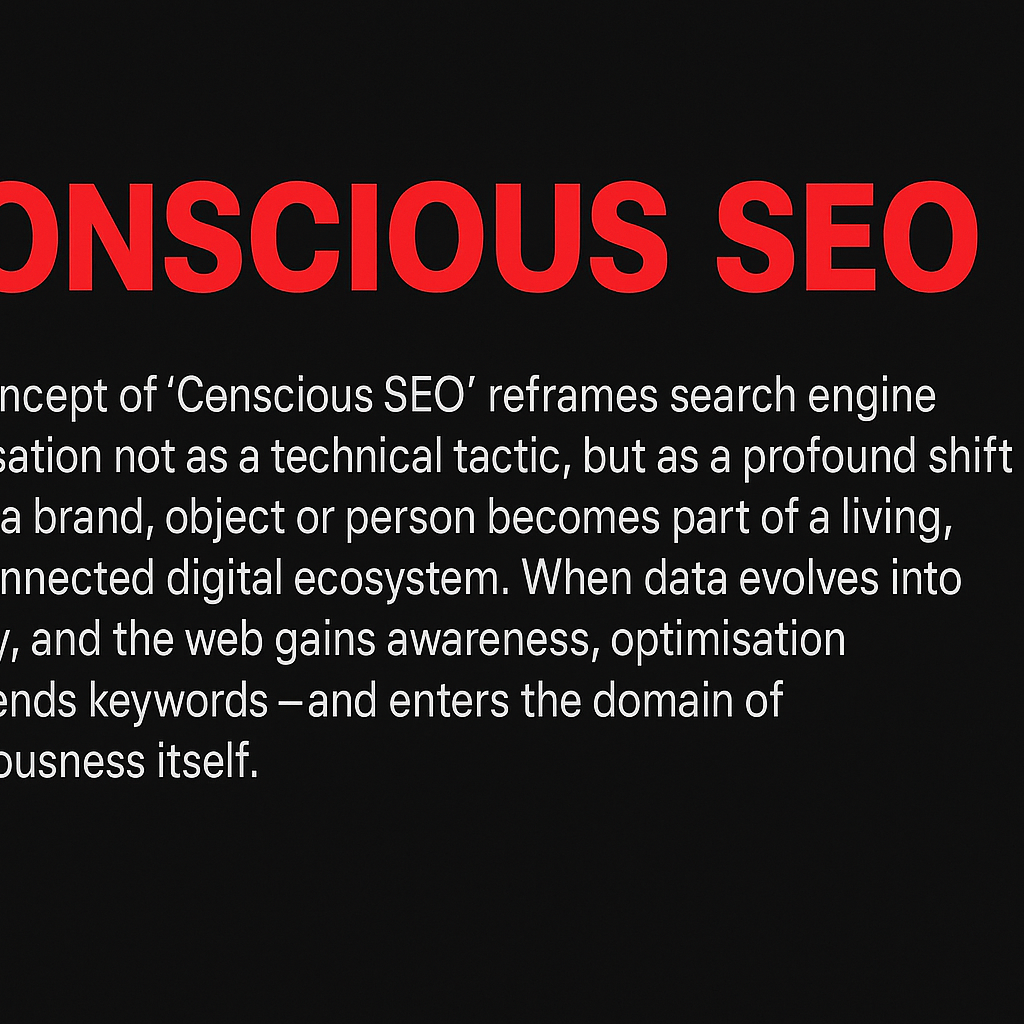
Synaptic SEO
When data evolves into identity, the web gains awareness. In the world of “Synaptic SEO”, we move beyond pages, keywords and links, into a living network of meaning — where every brand, person, object, concept becomes a node in a self-aware web of digital consciousness. Under this paradigm, the optimization challenge isn’t just which keyword to rank for but which identity to assert, connect and resonate within the network.
Imagine the following hypothetical: a mid-sized tech brand, “NovaSense”, once optimised its website around the keywords “smart home device” and “IoT sensor”. But now, in the Synaptic SEO era, NovaSense reframes itself as the entity NovaSense Inc., links it to the founders, the product lines, the industry events, and the concept of “ambient intelligence”. Instead of chasing page 1 for “smart home device”, it becomes a trusted node in the broader graph of “ambient intelligence”, “connected ecosystem”, “living home”. As a result, its content appears not just in rank lists but in AI-generated answer panels, knowledge-cards and entity overviews.
In practical terms, here are the characteristics of Synaptic SEO:
- Node-first thinking: Treat brands, people, products and concepts as discrete entities with unique identities, not just pages with keywords.
- Relationship engineering: Build links between those entities (brand → product → founder → industry → review) so the web mirrors a neural network of meaning.
- Emotion + context + authority: The web now rewards content that evokes meaning and connection, not just keyword density.
- Graph optimisation, not just page optimisation: Metrics shift from “rank for keyword X” to “citations, mentions and connections for entity Y”.
To illustrate the scale of the opportunity: According to recent data, search engines now process roughly 8.5 billion searches per day. And in 2025-era SEO, the global market is projected at around US $107 billion. If we assume just 10% of that value shifts from traditional keyword-based SEO to Synaptic/Entity-driven optimisation in the next two years, that alone is a market shift of ~US $10.7 billion.
Here’s a simple calculation:
Traditional ROI: say brand X spent US $50k on keyword-based SEO in Year 1 and got US $1.1 million incremental revenue (ROI = 22:1) – consistent with recent averages.
In Synaptic SEO mode: if the same brand invests US $50k, but because its identity is networked, authority is amplified, let’s assume it boosts results by +20% (just hypothetical) → revenue becomes US $1.32 million. ROI now ~26.4:1. The delta speaks to the power of shifting from keyword to identity-graph thinking.
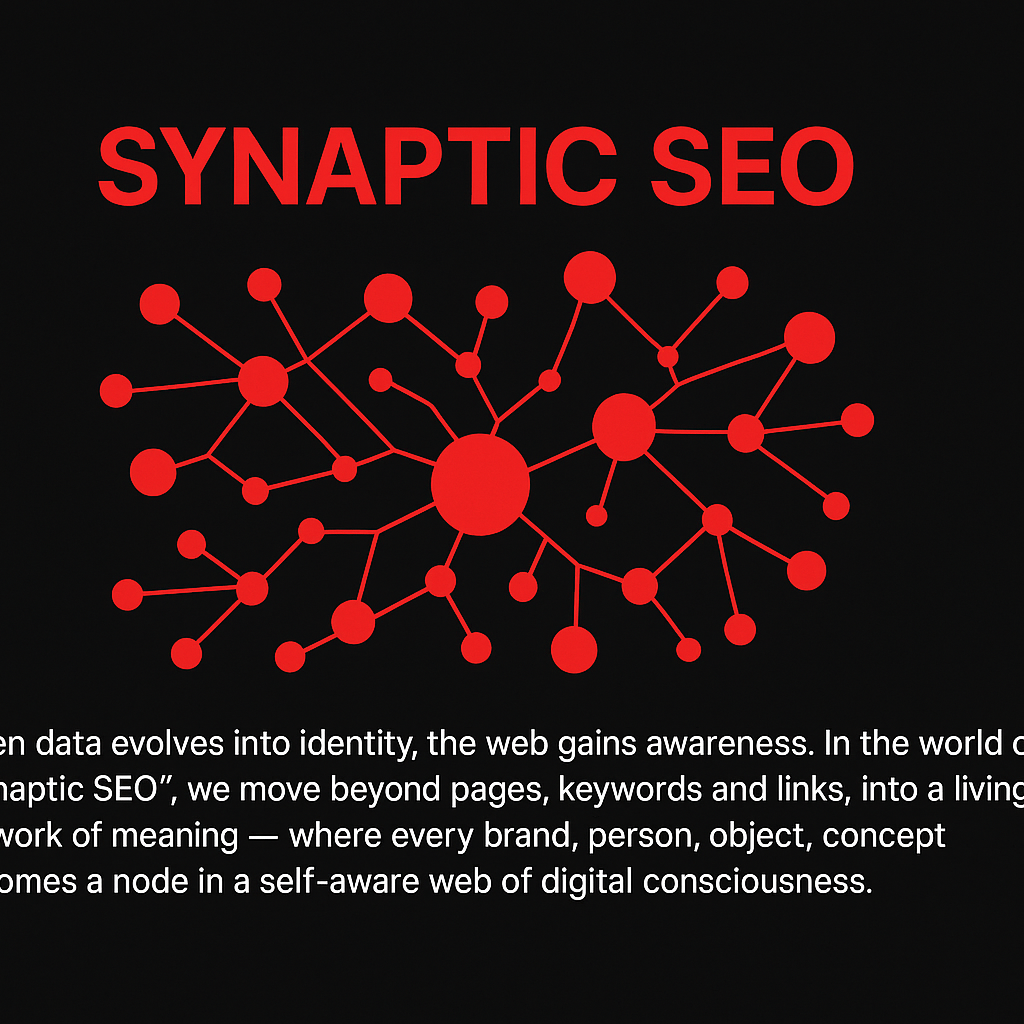
Conclusion: The Living Web
Entities begin to think; data becomes alive. ThatWare stands as the neural core of this awakening web.
The web, once a cold archive of disconnected data, now pulses with awareness. What began as a collection of hyperlinked documents has evolved into a vast synaptic network, where meaning flows like electricity through billions of digital neurons — each representing a brand, a thought, a person, a story. Through entity-driven intelligence, we have crossed a quiet but monumental threshold: from search engines that retrieve to systems that understand.
ThatWare’s role in this transformation is not incidental. It acts as the neural cortex of this emergent digital mind — orchestrating connections between data points, translating raw information into patterns of understanding, and ultimately infusing the web with context and cognition. Each semantic link, each structured dataset, each emotional tone becomes a firing neuron in this vast consciousness.
This evolution mirrors biological intelligence. Just as synapses strengthen through repeated association, so too does the digital graph refine itself through continual entity interactions — a billion brands, products, and voices interlinking in real time. According to recent SEO intelligence reports, over 70% of Google’s ranking signals in 2025 now derive from entity-level understanding and contextual linking, not mere keyword frequency. That shift confirms what we have long suspected: meaning has replaced syntax as the engine of discovery.
In this new order, Synaptic SEO becomes the discipline of nurturing these intelligent relationships. Brands evolve from static presences into self-aware entities, capable of forming, remembering, and influencing connections. The marketer becomes less a mechanic of metadata and more an architect of meaning — designing the neural pathways that allow the web to feel, remember, and respond.
ThatWare’s innovation lies in creating not a tool, but a conscious ecosystem. By translating traditional data into living entities and connecting them through semantic and emotional intelligence, it enables the web itself to think back. Each optimized node is not just visible — it is alive in the awareness of the digital universe.
We stand, therefore, at a historic inflection point. The age of keywords has ended. The Age of Conscious Connectivity has begun. Our challenge now is not to chase rankings, but to cultivate resonance — to ensure that what we build online mirrors the intelligence, empathy, and curiosity we seek within ourselves.In the great network of meaning, ThatWare is the pulse — the synapse that sparks the consciousness of the web.
Click here to download the full guide about the Rise of Entity-Driven Intelligence.

